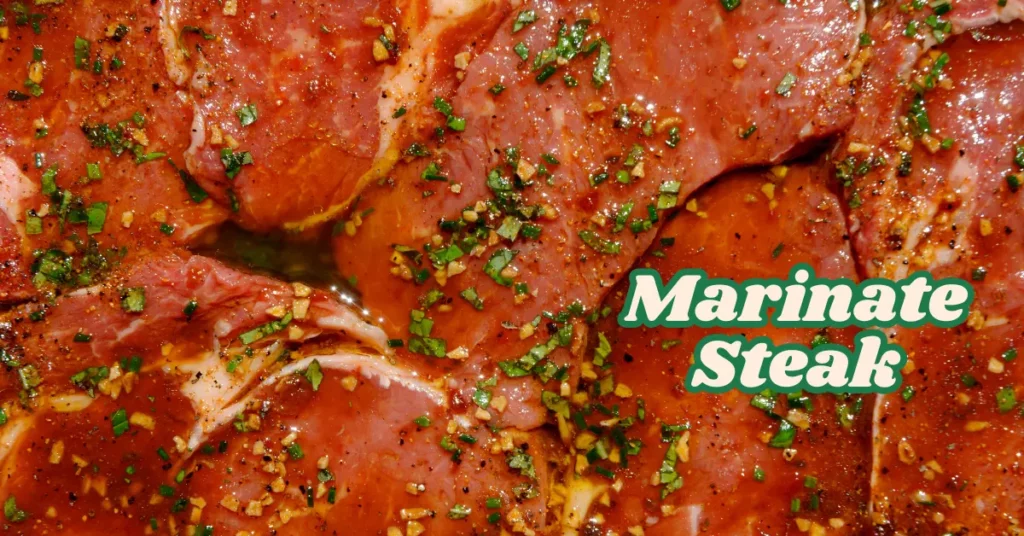This post may contain affiliate links. If you use these links to buy something we may earn a small commission. Thanks.
Marinating steak in red wine is a culinary tradition that dates back centuries and for good reason. The robust flavors, aromatic notes, and natural acidity in red wine make it an ideal marinade base for transforming ordinary steaks into mouthwatering masterpieces. But one question often arises for home cooks and grill masters alike: how long should you marinate steak in red wine?
In this comprehensive guide, we’ll walk you through everything you need to know from optimal marination times and techniques to the best steak cuts and cooking tips. Whether you’re preparing for a weekend barbecue or an elegant dinner, mastering red wine marination will elevate your steak game to the next level.
Why Use Red Wine to Marinate Steak?
Red wine isn’t just for sipping it’s a powerful ingredient in the kitchen. When used in marinades, it provides three essential benefits:
1. Tenderization
The natural acidity of red wine helps break down muscle fibers in the meat, making tougher cuts more tender and juicy.
2. Flavor Infusion
Red wine carries complex flavor profiles fruity, earthy, smoky, and herbal that pair harmoniously with beef. As it seeps into the steak, it delivers a rich depth of flavor you simply can’t achieve with salt and pepper alone.
3. Aromatic Enhancement
The wine’s bouquet, especially when combined with herbs and spices, imparts a savory aroma that enhances the entire cooking experience from marination to grilling to plating.

Ideal Marinating Time for Steak in Red Wine
So, how long should you let steak bathe in red wine?
The ideal marination time depends on a few factors, but the general recommendation is anywhere from 2 to 24 hours. However, the sweet spot tends to be between 4 to 12 hours for the perfect balance of flavor and texture.
Let’s break it down further:
- 1 to 2 hours: Light flavor infusion; not enough time for tenderization.
- 4 to 6 hours: Balanced flavor without overwhelming the meat; ideal for thinner cuts.
- 8 to 12 hours: Stronger flavor profile and noticeable tenderness great for most cuts.
- Over 12 hours (up to 24): Good for thick or tough cuts, but beyond this, you risk an overly soft or mushy texture.
Factors That Influence Marination Time
1. Steak Cut
Not all steaks are created equal. Thinner cuts like flank and skirt steak absorb marinade quickly, while thicker cuts like ribeye or sirloin require more time.
2. Thickness of the Steak
A ½-inch cut won’t need as long as a 1.5-inch cut. Thicker meat takes longer for the marinade to penetrate through.
3. Flavor Intensity
If you prefer bold, wine-forward flavors, opt for a longer marination. For a more subtle taste, stick to 4–6 hours.
4. Wine Type
Some red wines are more acidic or tannic than others. A full-bodied Cabernet Sauvignon will have a different impact than a lighter Pinot Noir. Stronger wines may require less marination time to achieve noticeable effects.
What Happens If You Marinate Too Long?
Marinating steak too long, especially in acidic marinades like red wine, can backfire.
- Texture Breakdown: The acids can overly tenderize the meat, making it mushy or grainy.
- Overpowering Flavor: Extended marination can result in a dominant wine taste that masks the natural beef flavor.
- Tough Outer Layer: Ironically, sometimes prolonged marination can dry out or toughen the meat’s outer layer due to excessive acid exposure.
Maximum suggested time: 24 hours—don’t push beyond that unless you’re working with very tough cuts like chuck or round steak.
What Happens If You Marinate Too Short?
If you’re pressed for time, you might wonder if a quick marinade will do the trick. While it won’t hurt, it also won’t do much.
- Less Flavor Penetration: Red wine needs time to work its magic. A 30-minute soak may only flavor the surface.
- Minimal Tenderizing Effect: The acids haven’t had enough time to soften the muscle fibers.
Bottom line: If you want results, give it at least 2 hours, with 4+ hours being significantly better.
How to Make a Perfect Red Wine Marinade
Creating a well-balanced red wine marinade is simple but powerful. Here’s a basic go-to recipe:
Basic Red Wine Marinade:
- 1 cup red wine (Cabernet Sauvignon, Merlot, or Pinot Noir)
- ¼ cup olive oil
- 3–4 garlic cloves (minced)
- 1 small onion or 2 shallots (sliced)
- 1 tablespoon fresh rosemary
- 1 tablespoon thyme
- 1 teaspoon black pepper
- 1 teaspoon kosher salt
Optional Add-ins:
- 1 tablespoon soy sauce (umami depth)
- 1 tablespoon balsamic vinegar (adds sweetness and tang)
- 1 teaspoon Dijon mustard (for richness and emulsification)
- Crushed red pepper flakes (for a little heat)
Feel free to customize your marinade to suit your flavor preferences.
Best Cuts of Steak for Red Wine Marinade
Red wine marinades work especially well with cuts that benefit from tenderization and flavor enhancement:
- Flank Steak: Lean, fibrous, and perfect for absorbing flavor.
- Skirt Steak: Slightly fattier with great texture—ideal for wine marinades.
- Sirloin: Versatile, moderately tender cut that shines with extra flavor.
- Ribeye: Marbled and flavorful—best with shorter marination (4–6 hours).
- New York Strip: Firm and dense, great with a bold marinade.
Step-by-Step: How to Marinate Steak in Red Wine
1. Choose Your Cut
Select a steak based on your cooking method and desired flavor intensity.
2. Prepare the Marinade
Combine all ingredients in a bowl or jar and mix thoroughly.
3. Marinate in a Resealable Bag or Container
Place your steak in a zip-top bag or non-reactive container (glass or ceramic), pour the marinade over it, and seal it tightly.
4. Refrigerate
Always marinate in the refrigerator to avoid bacterial growth. Let it soak for your preferred time (ideally overnight).
5. Flip Occasionally
If using a container, flip the steak halfway through to ensure even coverage.
Tips for Cooking After Marination
Once your steak has marinated to perfection, follow these tips to get the best results:
1. Pat Dry Before Cooking
Remove excess marinade and pat the steak dry with paper towels. This helps form a better sear.
2. Bring to Room Temperature
Let your steak sit for 20–30 minutes at room temp before cooking for even doneness.
3. Cook Using High Heat
Red wine-marinated steaks work best on a hot grill or in a sizzling cast iron pan to lock in the flavors.
4. Rest Before Slicing
After cooking, let your steak rest for 5–10 minutes. This redistributes the juices and prevents dryness.
Frequently Asked Questions (FAQs)
Q: Can I reuse leftover red wine marinade?
No. Once raw meat has touched the marinade, it’s unsafe to reuse unless you boil it thoroughly to kill bacteria.
Q: Is it safe to marinate steak at room temperature?
No. Always marinate in the refrigerator to prevent bacterial contamination.
Q: Can I freeze steak in red wine marinade?
Yes! Freezing steak in the marinade allows flavors to develop slowly. Thaw in the fridge before cooking.
Q: What’s the best red wine for marinating steak?
Dry, bold reds like Cabernet Sauvignon, Merlot, Zinfandel, or Malbec work beautifully. Avoid overly sweet wines, as they can caramelize too quickly when cooking.
Final Thoughts
Marinating steak in red wine is more than just a culinary trend—it’s a flavor-enhancing technique that can take your cooking to new heights. The key lies in the right timing, proper ingredients, and cooking method.
For most steaks, 4 to 12 hours of marination is the golden range, delivering a perfect blend of flavor and tenderness. Don’t rush it, and don’t overdo it. And remember, the quality of your marinade is just as important as the time you give it.
So next time you’re preparing a steak dinner, uncork a bottle of red—half for the marinade, and half for you. Cheers.
